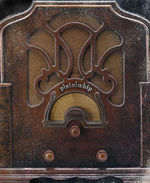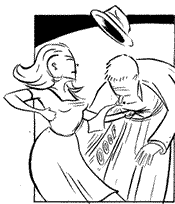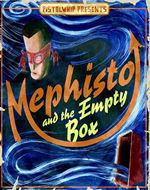>> Editorial: Camera Obscura - The Call
>> Editorial: Camera Obscura - Whisky Business
More...

Jason Hall is a Las Vegas escapee who became a producer for PBS in the great Northwest. Matt Kindt is a graphic designer who works on coffee table books in the Midwest. Like so many creative partnerships these days, they met on-line, through a mutual appreciation of Andrew Bird's music, and together they have produced two of the most talked about comics of the last year - PISTOLWHIP, and its companion piece, MEPHISTO AND THE EMPTY BOX.
They both came to comics through Marvel. Kindt started out reading his older brother's comics from the late seventies and early eighties, while Hall's first comic was an X-MEN book with Cyclops on the cover. He bought it because "he looked cool", although he's quick to point out that he's "come a long way since then".
His attention is currently occupied by the likes of HELLBOY, TOP TEN, ACME NOVELTY LIBRARY, AGE OF BRONZE, EVIL EYE and BONE, while Kindt's current reading pile includes BOX OFFICE POISON, ALEC, TINTIN, and Carl Barks' UNCLE SCROOGE.
PISTOLWHIP is a crime noir tale about private eyes and femme fatales that kicks against the conventions in some very unexpected ways. In creating PISTOLWHIP, Kindt was heavily influenced by the industrial design and architecture of the '30s and '40s, finding it "so great and so fun to draw that I thought I'd start there to keep me interested artistically," having become tired of the autobiographical comics that he'd been working on.
Hall shares his love of the period. "Comics, music, style, art, clothes, movies, books, architecture, all of it. Raymond Chandler's character Philip Marlowe has certainly had a deep emotional effect on me. Old black & white movies, from screwball comedies to film noir, along with Alfred Hitchcock movies, are definitely an influence.
 "And listening to the Hot Club of France or, say, The Mooch by Duke Ellington, just touches my soul - it's like I'm at home. Today, so many things are bland and corporate, possessing no character. But, then again, back then racism was at its peak and you had the Depression, so I guess I'm probably romanticising it a bit too."
"And listening to the Hot Club of France or, say, The Mooch by Duke Ellington, just touches my soul - it's like I'm at home. Today, so many things are bland and corporate, possessing no character. But, then again, back then racism was at its peak and you had the Depression, so I guess I'm probably romanticising it a bit too."
But it's not just the Noir aesthetic that they love. Says Kindt, "I also have some kind of strange fascination with pirates, and my wife really got me into the whole aesthetic of the circus. We actually own the real circus freak banner of 'Snake Girl' that we found at an antique store. It's over our fireplace. An obvious inspiration for Snake Girl in the book.
"There's a ton of other small little homages and references to some of my influences stuck in there everywhere, but I'd hate to give it all away... they're more fun hidden!"
Their wives actually share the love of that sort of circus. Notes Hall, "My wife absolutely loves the old sideshows and circus freaks - so it was neat to see that in the PISTOLWHIP book (and I'm sure it will pop up again down the road). I'm with Matt in that I love putting in 'hidden' references to things that I love and am influenced by in everything I write. I think it also makes the re-reading experience a lot more fun too!"
PISTOLWHIP began life as a single-issue comic that Kindt wrote and drew alone. He had originally planned to have everyone die at the end, but became so attached to the characters that felt he had to expand it into a larger, 120-page book.
It was around then that he got talking to Hall. "He had some good ideas for things to add into it and for future books, to really make it a kind of world instead of just an isolated story.
"I like self-contained stories, and Jason is more of an 'ongoing continuity' man, so we compromised. PISTOLWHIP then turned into a series of books, each one a self-contained story, but also part of a larger world and bigger idea."
Hall clarifies his contribution to the first set of PISTOLWHIP stories, explaining that he wrote and designed the layouts for MEPHISTO and worked on the art direction. "In the PISTOLWHIP book, I did some additional writing, which includes some dialogue, the text pages, and some background characters - most of which sets up stuff for my story in the next big book.
"I also had a couple layout suggestions and helped with the internal art direction. And even though the next book is my 'baby', so to speak, much the same way PISTOLWHIP was Matt's, we always talk about the story and the artwork and everything and I like to think the best of what each of us has to offer ends up in the comic."
So they're planning more?
"The follow-up graphic novel will be out in 2002 ... and it's going to be quite the epic. I finished writing it awhile ago and Matt is already far along in the artwork." says Hall.
 It doesn't end there, though, as Kindt adds; "As for the future, I've got another non-PISTOLWHIP graphic novel tentatively titled TWO SISTERS that is written and ready to go, as well as a few other shorter pieces. I'd just as soon stay with Top Shelf. As long as they're willing to put my stuff out there, I'm content."
It doesn't end there, though, as Kindt adds; "As for the future, I've got another non-PISTOLWHIP graphic novel tentatively titled TWO SISTERS that is written and ready to go, as well as a few other shorter pieces. I'd just as soon stay with Top Shelf. As long as they're willing to put my stuff out there, I'm content."
Indeed, both creators have great things to say about their relationship with their publisher. As Kindt says, "If I could have picked any one publisher to work with in the industry, it would have been them. They have such great respect for the artists and really really love comics. They're an inspiration. When I think about all the things that might have happened or not happened with PISTOLWHIP I just feel really lucky."
It was getting the deal with Top Shelf that enabled them to put PISTOLWHIP out in the format they did, not simply as a trade (they had originally thought of self-publishing it as a six issue mini-series, with MEPHISTO as the final issue), but as a rather unusual looking trade.
As Hall puts it, they felt it had to look "interesting and unique and somewhat enigmatic," adding, "it also had to make sense in relation to the story. When working on the art direction, we both think of what's the kind of book we'd like to see on the shelf, and then hope others will feel the same way."
As the man responsible for the design, Kindt was relieved to be able to do exactly what he felt was best for the book. "I'm so used to working on designs and having them changed and re-worked and basically wrecked by clients that it felt good to just come up with a concept that worked and then have Brett [Warnock, production] and Chris [Staros, editorial] totally behind it and excited. I'm concerned about it looking good, but the concept to me is more important. Does it make sense, or is it just decoration to look pretty? That's the big question. I hate design for design's sake."
If the deal with Top Shelf enabled them to put out an unconventional book, they certainly managed to get noticed in an unconventional way. At the San Diego Comicon in 2000, they handed round a rather unique sort of pitch...
"The one thing we knew starting out was that competition is fierce and we'd be lucky to even get something looked at," admits Hall. "We knew we needed to do something unique, something that hadn't been done before. So we decided to create completely finished mock-ups of both books, including specially chosen paper stock and full-colour covers. At first, Top Shelf had even thought they were comp books already published, not actually a submission.
"But we didn't stop there; if we were going to make the books look like a finished product, then we might as well create some promo items to go along with it. So we thought of all the cool things we'd like as promo items, and that's what we made: '40s tobacco trading cards, a fake cigarette, a paper doll, postcards of 'vacation spots' in the world of our books, and even a mini-comic 'explaining' what we wanted to do with PISTOLWHIP.
"Top Shelf liked our little trinkets so much they had us make more with their logo to promote the books."
It was Kindt's design background that lead them to this - "I've always had it pounded into my head that 'presentation is everything'. That pretty much holds true for at least getting your foot in the door. If I was going to be a failure then I really wanted to at least feel like I'd done everything I could."
 That's the story behind PISTOLWHIP, but what led to MEPHISTO AND THE EMPTY BOX, the single issue comic that revisits the PISTOLWHIP world and stirs in escapology and magic?
"I had the idea for this story years ago, and many of the themes in it come from my outlook on the world and how I relate to it," says Hall. "Once Matt and I met and decided PISTOLWHIP was going to be the beginning of our little 'universe' we were going to work in, I thought my MEPHISTO story would fit right in.
That's the story behind PISTOLWHIP, but what led to MEPHISTO AND THE EMPTY BOX, the single issue comic that revisits the PISTOLWHIP world and stirs in escapology and magic?
"I had the idea for this story years ago, and many of the themes in it come from my outlook on the world and how I relate to it," says Hall. "Once Matt and I met and decided PISTOLWHIP was going to be the beginning of our little 'universe' we were going to work in, I thought my MEPHISTO story would fit right in.
"I don't think of MEPHISTO as a companion to PISTOLWHIP, but as its own unique separate entity. I think it tends to get overshadowed a bit because it's a 24-page comic compared to a 128-page graphic novel, but I think the story stands on it's own.
"All our stories do take place in the same 'universe', for lack of a better word, but they can be read and enjoyed separately. Careful readers will catch a variety of things from one book that appears in the other, and this definitely holds true with the next graphic novel.
"Technically, MEPHISTO takes place 8 1/2 years before PISTOLWHIP. I've even got a timeline worked out, which we'll probably put up on the electronic headquarters once the next book comes out."
Kindt expounds on this; "That's kind of how I had initially seen the PISTOLWHIP 'universe' as well. It's a place to tell really any kind of story without really being trapped in any particular genre. It seems that people's initial response is to fit it into a sort of crime genre, but really I think people will be surprised by the follow-up books. Every book will fit together, but there's a few ideas on the horizon, including a younger Mrs. Dalloway travel story, and some other kind of offbeat stuff."
In summing up their approach to comics, Hall gets the last word. "We like to tell stories that are enjoyed on the first read, but then are appreciated even more so on the second and third time through."
You can read more on PISTOLWHIP at pistolwhipcomics.com.

This article is Ideological Freeware. The author grants permission for its reproduction and redistribution by private individuals on condition that the author and source of the article are clearly shown, no charge is made, and the whole article is reproduced intact, including this notice.


